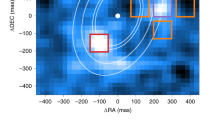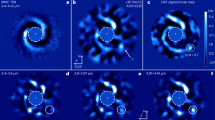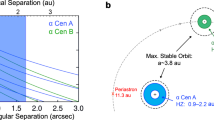Abstract
Exoplanet detections have revolutionized astronomy, offering new insights into solar system architecture and planet demographics. While nearly 1,900 exoplanets have now been discovered and confirmed1, none are still in the process of formation. Transition disks, protoplanetary disks with inner clearings2,3,4 best explained by the influence of accreting planets5, are natural laboratories for the study of planet formation. Some transition disks show evidence for the presence of young planets in the form of disk asymmetries6,7 or infrared sources detected within their clearings, as in the case of LkCa 15 (refs 8, 9). Attempts to observe directly signatures of accretion onto protoplanets have hitherto proven unsuccessful10. Here we report adaptive optics observations of LkCa 15 that probe within the disk clearing. With accurate source positions over multiple epochs spanning 2009–2015, we infer the presence of multiple companions on Keplerian orbits. We directly detect Hα emission from the innermost companion, LkCa 15 b, evincing hot (about 10,000 kelvin) gas falling deep into the potential well of an accreting protoplanet.
This is a preview of subscription content, access via your institution
Access options
Subscribe to this journal
Receive 51 print issues and online access
$199.00 per year
only $3.90 per issue
Buy this article
- Purchase on Springer Link
- Instant access to full article PDF
Prices may be subject to local taxes which are calculated during checkout



Similar content being viewed by others
References
Akeson, R. L. et al. The NASA Exoplanet Archive: data and tools for exoplanet research. Publ. Astron. Soc. Pacif. 125, 989–999 (2013)
Andrews, S. M. et al. Resolved images of large cavities in protoplanetary transition disks. Astrophys. J. 732, 42–66 (2011)
Strom, K. M., Strom, S. E., Edwards, S., Cabrit, S. & Skrutskie, M. F. Circumstellar material associated with solar-type pre-main-sequence stars - a possible constraint on the timescale for planet building. Astron. J. 97, 1451–1470 (1989)
Calvet, N. et al. Disks in transition in the Taurus population: Spitzer IRS spectra of GM Aurigae and DM Tauri. Astrophys. J. 630, L185–L188 (2005)
Bryden, G., Chen, X., Lin, D. N. C., Nelson, R. P. & Papaloizou, J. C. B. Tidally induced gap formation in protostellar disks: gap clearing and suppression of protoplanetary growth. Astrophys. J. 514, 344–367 (1999)
Isella, A. et al. An azimuthal asymmetry in the LkHα 330 disk. Astrophys. J. 775, 30–40 (2013)
Pérez, L. M., Isella, A., Carpenter, J. M. & Chandler, C. J. Large-scale asymmetries in the transitional disks of SAO 206462 and SR 21. Astrophys. J. 783, L13–L18 (2014)
Kraus, A. L. & Ireland, M. J. LkCa 15: a young exoplanet caught at formation? Astrophys. J. 745, 5–16 (2012)
Ireland, M. J. & Kraus, A. L. Orbital Motion and Multi-Wavelength Monitoring of LkCa15 b . In Booth, M., Matthews, B. C. & Graham, J. R. (eds) Exploring the Formation and Evolution of Planetary Systems, Vol. 299 of IAU Symposium, 199–203 (2014)
Whelan, E. T. et al. Spectro-astrometry of LkCa 15 with X-Shooter: searching for emission from LkCa 15b. J. Astron. Astrophys . 579, A48 (2015)
Tuthill, P. G., Monnier, J. D. & Danchi, W. C. Aperture masking interferometry on the Keck I Telescope: new results from the diffraction limit . In Léna, P. & Quirrenbach, A. (eds) Interferometry in Optical Astronomy, Vol. 4006 of Society of Photo-Optical Instrumentation Engineers (SPIE) Conference Series, 491–498 (2000)
Close, L. M. et al. Discovery of Hα emission from the close companion inside the gap of transitional disk HD 142527. Astrophys. J. 781, L30–L34 (2014)
Marois, C., Nadeau, D., Doyon, R., Racine, R. & Walker, G. A. H. Differential simultaneous imaging and faint companions: TRIDENT first results from CFHT . In Martín, E. (ed.) Brown Dwarfs, Vol. 211 of IAU Symposium, 275–278 (2003)
Thalmann, C. et al. The architecture of the LkCa 15 transitional disk revealed by high-contrast imaging. J. Astron. Astrophys . 566, A51 (2014)
Gladman, B. Dynamics of systems of two close planets. Icarus 106, 247–263 (1993)
Beaugé, C., Ferraz-Mello, S. & Michtchenko, T. A. Extrasolar planets in mean-motion resonance: apses alignment and asymmetric stationary solutions. Astrophys. J. 593, 1124–1133 (2003)
Eisner, J. A. Spectral energy distributions of accreting protoplanets. Astrophys. J. 803, L4–L8 (2015)
Zhu, Z. Accreting circumplanetary disks: observational signatures. Astrophys. J. 799, 16–24 (2015)
Spiegel, D. S. & Burrows, A. Spectral and photometric diagnostics of giant planet formation scenarios. Astrophys. J. 745, 174–188 (2012)
Skrutskie, M. F. et al. The two micron all sky survey (2MASS). Astron. J. 131, 1163–1183 (2006)
Rebull, L. M. et al. The Taurus Spitzer survey: new candidate Taurus members selected using sensitive mid-infrared photometry. Astrophys. J. 186, 259–307 (2010)
Zhou, Y., Herczeg, G. J., Kraus, A. L., Metchev, S. & Cruz, K. L. Accretion onto planetary mass companions of low-mass young stars. Astrophys. J. 783, L17–L22 (2014)
Rigliaco, E. et al. X-shooter spectroscopy of young stellar objects. I. Mass accretion rates of low-mass T Tauri stars in σ Orionis. J. Astron. Astrophys . 548, A56 (2012)
Hartmann, L., Hewett, R. & Calvet, N. Magnetospheric accretion models for T Tauri stars. 1: Balmer line profiles without rotation. Astrophys. J. 426, 669–687 (1994)
Kenyon, S. J. & Hartmann, L. Pre-main-sequence evolution in the Taurus-Auriga molecular cloud. Astrophys. J. 101, 117–171 (1995)
Gullbring, E., Hartmann, L., Briceño, C. & Calvet, N. Disk accretion rates for T Tauri stars. Astrophys. J. 492, 323–341 (1998)
Ayliffe, B. A. & Bate, M. R. Migration of protoplanets with surfaces through discs with steep temperature gradients. Mon. Not. R. Astron. Soc. 415, 576–586 (2011)
Thalmann, C. et al. Optical imaging polarimetry of the LkCa 15 protoplanetary disk with SPHERE ZIMPOL. Astrophys. J. 808, L41–L47 (2015)
Isella, A., Chandler, C. J., Carpenter, J. M., Pérez, L. M. & Ricci, L. Searching for circumplanetary disks around LkCa 15. Astrophys. J. 788, 129–135 (2014)
Hinz, P. M. et al. Status of the LBT interferometer. In Society of Photo-Optical Instrumentation Engineers (SPIE) Conference Series Vol. 7013 28–36 (2008)
Leisenring, J. M. et al. On-sky operations and performance of LMIRcam at the Large Binocular Telescope. In Society of Photo-Optical Instrumentation Engineers (SPIE) Conference Series Vol. 8446 4–19 (2012)
Maire, A.-L. et al. The LEECH exoplanet imaging survey. Further constraints on the planet architecture of the HR 8799 system. J. Astron. Astrophys . 576, A133 (2015)
Martinache, F. Kernel phase in Fizeau interferometry. Astrophys. J. 724, 464–469 (2010)
Ireland, M. J. Phase errors in diffraction-limited imaging: contrast limits for sparse aperture masking. Mon. Not. R. Astron. Soc. 433, 1718–1728 (2013)
Sallum, S. et al. New spatially resolved observations of the T Cha transition disk and constraints on the previously claimed substellar companion. Astrophys. J. 801, 85–107 (2015)
Lafrenière, D., Marois, C., Doyon, R., Nadeau, D. & Artigau, É. A new algorithm for point-spread function subtraction in high-contrast imaging: a demonstration with angular differential imaging. Astrophys. J. 660, 770–780 (2007)
Buscher, D. F. Direct maximum-entropy image reconstruction from the bispectrum. In Very High Angular Resolution Imaging (eds Robertson, J. G. & Tango, W. J.) 91–93 (Vol. 158 of IAU Symposium, 1994)
Ireland, M. J., Monnier, J. D. & Thureau, N. Monte-Carlo imaging for optical interferometry. In Society of Photo-Optical Instrumentation Engineers (SPIE) Conference Series Vol. 6268 1T1–1T8 (2006)
Lawson, P. R. et al. 2006 interferometry imaging beauty contest. In Society of Photo-Optical Instrumentation Engineers (SPIE) Conference Series Vol. 6268 1U1–1U12 (2006)
Markwardt, C. B. Non-linear Least-squares Fitting in IDL with MPFIT. In Astronomical Data Analysis Software and Systems XVIII (eds Bohlender, D. A., Durand, D. & Dowler, P.) Vol. 411 of Astronomical Society of the Pacific Conference Series, 251 (2009)
Morzinski, K. et al. MagAO: Status and on-sky performance of the Magellan adaptive optics system. In Society of Photo-Optical Instrumentation Engineers (SPIE) Conference Series Vol. 914804 1–13 (2014)
Close, L. et al. First closed-loop visible AO test results for the advanced adaptive secondary AO system for the Magellan Telescope: MagAO’s performance and status. In Society of Photo-Optical Instrumentation Engineers (SPIE) Conference Series Vol. 8447 0X1–0X16 (2012)
Follette, K. B. et al. The first circumstellar disk imaged in silhouette at visible wavelengths with adaptive optics: MagAO imaging of Orion 218-354. Astrophys. J. 775, L13–L17 (2013)
Marois, C. et al. Direct imaging of multiple planets orbiting the star HR 8799. Science 322, 1348–1352 (2008)
Marois, C., Lafrenière, D., Doyon, R., Macintosh, B. & Nadeau, D. Angular differential imaging: a powerful high-contrast imaging technique. Astrophys. J. 641, 556–564 (2006)
Soummer, R., Pueyo, L. & Larkin, J. Detection and characterization of exoplanets and disks using projections on Karhunen-Loève eigenimages. Astrophys. J. 755, L28–L32 (2012)
Males, J. R. et al. Magellan adaptive optics first-light observations of the exoplanet β Pic B. I. Direct imaging in the far-red optical with MagAO+VisAO and in the near-IR with NICI. Astrophys. J. 786, 32–53 (2014)
Mawet, D. et al. Fundamental limitations of high contrast imaging set by small sample statistics. Astrophys. J. 792, 97–107 (2014)
Levison, H. F. & Duncan, M. J. SWIFT: A solar system integration software package. Astrophysics Source Code Library (2013)
Duncan, M. J., Levison, H. F. & Lee, M. H. A multiple time step symplectic algorithm for integrating close encounters. Astron. J. 116, 2067–2077 (1998)
Faber, P. & Quillen, A. C. The total number of giant planets in debris discs with central clearings. Mon. Not. R. Astron. Soc. 382, 1823–1828 (2007)
Acknowledgements
This work was supported by NSF AAG grant no. 1211329 and NASA OSS grant NNX14AD20G. This material is based upon work supported by the National Science Foundation under grant no. 1228509. This work was performed in part under contract with the California Institute of Technology (Caltech) funded by NASA through the Sagan Fellowship Program executed by the NASA Exoplanet Science Institute. This material is based upon work supported by the National Science Foundation Graduate Research Fellowship under grant no. DGE-1143953. Any opinion, findings, and conclusions or recommendations expressed in this material are those of the authors(s) and do not necessarily reflect the views of the National Science Foundation.
Author information
Authors and Affiliations
Contributions
This work merged two independently acquired and analysed data sets. S.S. led preparation of the manuscript, the orbital fits, and the acquisition and analysis of the LBT data while K.B.F. led the acquisition and analysis of the MagAO data, development of the MagAO SDI pipeline, and drafted MagAO manuscript sections. S.S., K.B.F., J.E., L.C., P.H., A.S., J.M., and K.M. contributed to one or both observing proposals. J.E. modelled circumplanetary disk and hot-start scenarios, developed the NRM mode at LBT, and supervised effort of S.S.; L.C. carried out Hα luminosity calculations and oversaw the MagAO effort. P.H. led LBTI development and support, and helped commission the NRM mode at LBT. K.K. carried out orbital stability analysis. J.M. developed the KLIP code used in MagAO data analysis. P.T. helped develop the NRM mode at LBT. B.M. supervised the effort of K.B.F.; S.S., K.B.F., J.E., L.C., and K.K. contributed key aspects of the manuscript. A.S., V.B., D.D., E.S., and A.V. supported the LBT observations. J.M., K.M., T.R., and A.W. supported the MagAO observations.
Corresponding author
Ethics declarations
Competing interests
The authors declare no competing financial interests.
Extended data figures and tables
Extended Data Figure 1 Image reconstructions.
a–d, Images reconstructed from closure phases, showing Ks polynomial (a) and LOCI-like (b) calibrations, and L′ polynomial (c) and LOCI-like (d) calibrations. Both calibrations yielded reconstructed images with at least two distinct components. The LOCI-like calibration moved each companion within the position errors derived from the grid χ2 surface.
Extended Data Figure 2 KLIP and ADI Hα SNR maps.
a–c, Final KLIP SNR maps for Hα (a), continuum (b) and the difference between the two (ASDI, c). d–f, Final cADI SNR maps in the same order. Dividing by the radial noise profiles to create these maps should normalize the noise distribution at all radii within the speckle-dominated regime. The presence of dark holes in the maps suggests that we are speckle-dominated out to the AO control radius at r ≈ 20 pixels (white, dashed circles). LkCa 15 b’s separation is 11.6 pixels. The yellow keystones indicate the 2σ range of allowed astrometry for the KLIP ASDI point source (upper right) based on negative simulated planet injection.
Extended Data Figure 3 False positive planet SNR maps.
a, LkCa 15 final ASDI SNR map. b, ASDI SNR map with LkCa 15 b removed. c–h, ASDI SNR maps of false positive planets injected at a radius of 11 pixels and contrast of 8 × 10−3 . Recovered parameters for these planets are given in Extended Data Table 2 and were used to determine 1σ astrometric and photometric uncertainties.
Extended Data Figure 4 Hα detection noise statistics.
a, Histogram of noise (non-planet) pixel values in the SNR map within the speckle dominated regime (black line) compared to a Normal distribution (red line). The black arrow denotes the location of the peak SNR value for LkCa 15 b. b, Histogram of the peak values in all noise apertures (see Extended Data Fig. 5) within the control radius (black line) compared to a Normal distribution (red line). The black arrow shows the peak pixel value in the LkCa 15 b aperture.
Extended Data Figure 5 Noise apertures.
Noise apertures (black circles) surrounding LkCa 15 A used to calculate the statistics presented in Extended Data Fig. 4. Colour indicates SNR.
Extended Data Figure 6 LkCa 15 d position angle and separation versus time.
Evolution of position angle and separation (inset) for LkCa 15 d. Green and red points indicate Ks and L′ data, respectively. In both panels, the earliest three points correspond to previously published Keck observations8, and the most recent points show best fits to our data. The coloured error bars are derived using the nonlinear algorithm MPFIT, which significantly underestimates the parameter errors compared to the more robust grid, Δχ2 (black error bars; see Methods). The yellow shaded region spans the position angles and separations allowed at 1σ by the multi-epoch observations, which have semi-major axes between 12.6 and 24.7 au. Solid curves show the best-fit orbit (18.0 au), and dashed curves show an orbit (24.7 au) that is stable for a 0.5 MJ planet exterior to LkCa 15 b and c. Lower mass planets or resonant configurations permit stable orbits for LkCa 15 d at smaller stellocentric radii.
Extended Data Figure 7 Orbital integration results.
a, Stable orbits for LkCa 15 b, c, and d over a 10 Myr integration. b, Osculating eccentricity. The planets are each 0.5 MJ with initial semi-major axes of 12.7, 18.6, and 24.7 au, initial eccentricities of order 10−5, and relative inclinations of <1°. After a 10 Myr integration, the eccentricities of c and d have increased to only a few percent.
Rights and permissions
About this article
Cite this article
Sallum, S., Follette, K., Eisner, J. et al. Accreting protoplanets in the LkCa 15 transition disk. Nature 527, 342–344 (2015). https://doi.org/10.1038/nature15761
Received:
Accepted:
Published:
Issue Date:
DOI: https://doi.org/10.1038/nature15761
This article is cited by
-
Optical quantum super-resolution imaging and hypothesis testing
Nature Communications (2022)
Comments
By submitting a comment you agree to abide by our Terms and Community Guidelines. If you find something abusive or that does not comply with our terms or guidelines please flag it as inappropriate.



